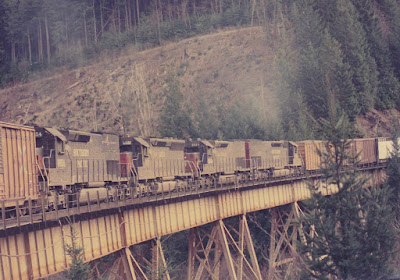In March 1992, our family took a vacation to Northern California. I was 11 years old. This vacation seems like a good place to start for a relaunch, even though I may repeat a thing or two that have posted before.
My dad took these pictures at Southern Pacific's Salt Creek Trestle in the Oregon Cascades on March 13, 1992. A forest service road off of Oregon Highway 58 provided access to one end of the Salt Creek Trestle. We didn't have to wait long for a Southern Pacific freight train to approach the trestle.
 |
| Photo by Cliff West |
The first railway to directly connect Oregon and California was Southern Pacific's line over Siskiyou Summit, which was completed on December 17, 1887, but mountainous route featured sharp curves and grades of up to 3.67%, the steepest on the entire railroad. In the early 1900s, construction started on a new route through the Cascade Range over Pengra Pass, but came to a halt in 1912. Progress on this new Cascade Line, or Natron Cutoff, didn't resume until 1923. The line was completed on September 1, 1926, and opened to through passenger service on April 17, 1927. The new Cascade Line was 25 miles shorter than Siskiyou Line and had a maximum grade of 2.2%, but it was still a demanding route, with 44-miles of continuous grade.
 |
| Photo by Cliff West |
Here are the three lead locomotives of the freight train starting across the Salt Creek Trestle. The Salt Creek Trestle carries the Southern Pacific's Cascade Line over Salt Creek and Oregon Highway 58 near Heather, Oregon. It was built in 1924 and was fabricated by the American Bridge Company of New York. The steel trestle is 1200 feet long with individual spans of up to 125 feet.
 |
| Photo by Cliff West |
In the middle of the freight train were four Southern Pacific helper locomotives. These locomotives are necessary for the train to climb the steep grades and negotiate the tight curves of this mountainous route.
There were no more helpers at the end of the train or even a caboose, just a Flashing Rear End Device, or FRED.
I took pictures myself but ended up misplacing the camera later in the trip. I also intended to keep a journal of the trip but gave up after the first entry. Here is what I wrote (including misspellings and errors):
Today we left on our trip. Hopefully we will make it to Kalamath Falls or Kalama de Flats (Dad's name for Kalamath Falls).
"Train" oh brother, its train time. We found a train and a photo stop. "We got signals, here she comes." Here came the train. I took a picture of the lead SD-40T-2 coming head on. Three SD-40T-2s on the head end. I was resetting my camera when "Oh my god, helpers." Three more SD-40T-2s and a SD-45. I wasn't ready for the lead helper so I got the trailing helper. I got ready for the caboose, but "Where's my bay window?" All that was there was FRED. I took my last picture which was of FRED. "Ok folks, that's a rap."

No comments:
Post a Comment